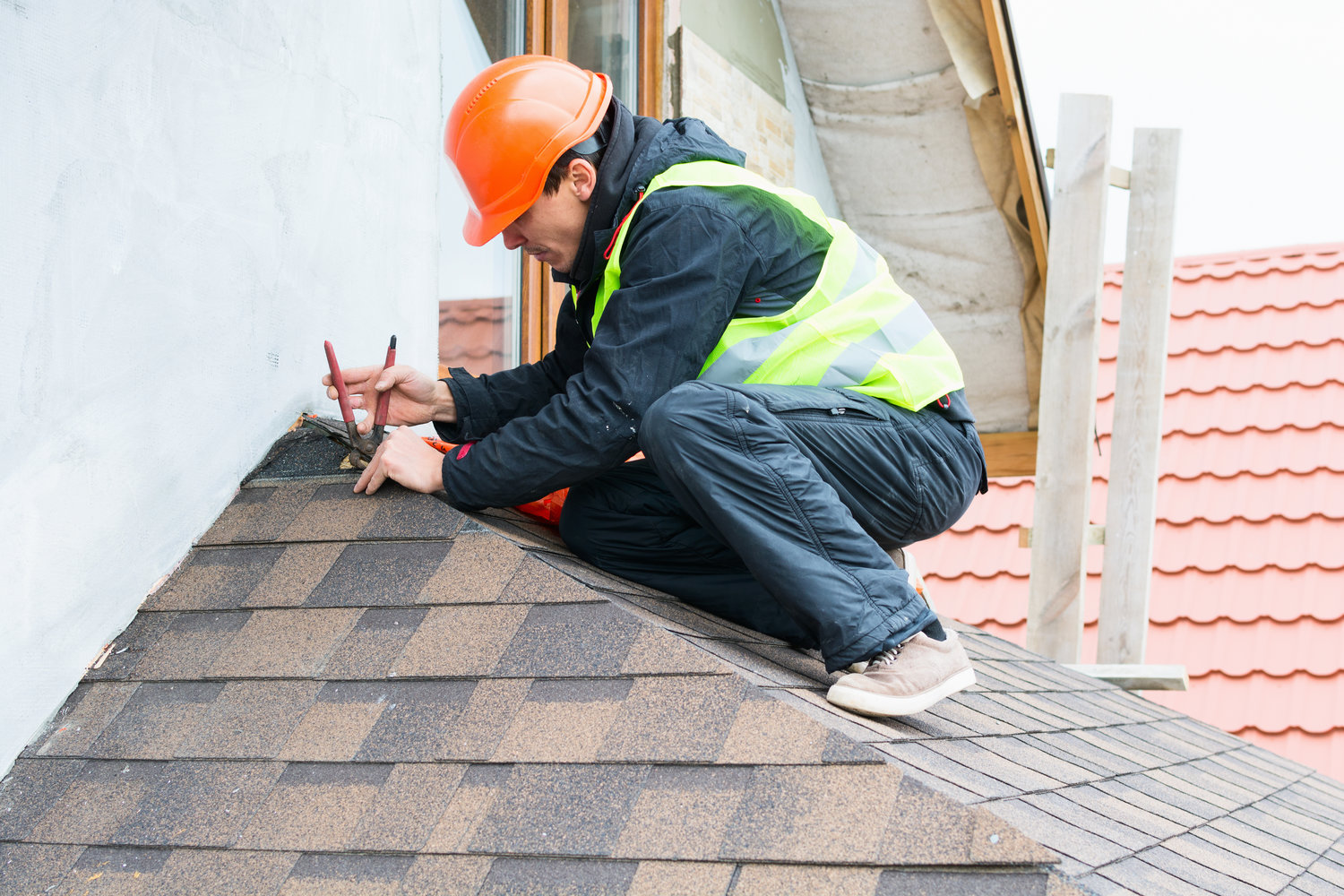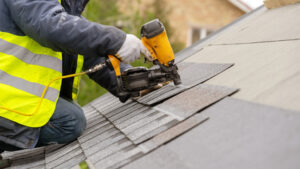Roofers In West Chester are hired to install or repair roofs on commercial buildings, homes, and other structures. They must be familiar with a wide range of roofing materials and techniques.
Residential roofers may work on sloped or flat roofs. They use ladders, scaffolding, or other equipment to access the roof and complete repairs. They must be able to follow safety guidelines when working on rooftops.

Roofers often work on homes and multi-unit housing, installing and repairing roofs. They may need to navigate through residential neighborhoods to access rooftops, so they must be mindful of the safety of nearby residents and properties. They also interact with homeowners, answering questions and explaining the process. Residential roofers may also be responsible for laying down new roof tiles or re-slating existing tile and slate roofs. Some also fit skylight windows and replace lead sheeting and cladding.
Some Roofers specialize in working with insurance claims, performing inspections for real estate companies, or offering zero-interest financing. They focus on making it convenient to do business with them by scheduling appointments online and providing a job site support person who can answer questions and interface with the crews on your behalf. Critical skills for Roofers include coordination, active listening, and critical thinking. They use a variety of tools including roofing shovels, pry bars, hammers, nail guns, tape measures, ladders, and framing squares to install or repair roofs.
Commercial roofers use a variety of materials including metal, shingles, tile, and wood to create and repair commercial building roofs. They inspect the roofs of businesses to determine the best replacement or repair procedure. They also work on high-rise buildings and may need to use special equipment to hoist materials onto the roof’s surface. In some cases, roofers will remove existing roofing materials from a commercial roof before installing a new roof.
Some commercial clients are more specific about what type of flat or low-sloped roof they want, and they will often hire a roofing contractor to meet their exact requirements. Skujins has worked with engineering firms, roofing consultants and property managers who demand that a new roof be installed within a certain time frame and with a specific warranty.
Some roofing services that commercial roofers provide include repairing leaks, sealing cracks, replacing broken tiles and shingles, and resealing seams on flat or low-sloped roofs. They can also level and smooth the surfaces of a roof to give it a clean, polished appearance. They can also install and replace gutters on the roofs of commercial buildings. They may also clean up the work zone after completing a job and remove debris from the site. They can even work around businesses that are still operating during the reroofing process by scheduling their service after hours or on weekends.
Roofers, also known as roofing contractors, are responsible for installing, repairing, and maintaining the roofs of buildings. They may work on homes, businesses, and industrial facilities. They use a variety of materials, including shingles, metal, and flat-roof systems. They can also install insulation to improve energy efficiency and reduce costs. Roofers often work on teams, and are expected to follow project plans and safety regulations.
During construction, they will rip off existing shingles and inspect the sheathing for damage or decay. They will then replace the sheathing and install a new roof with appropriate roofing materials. They will also clean up the site and dispose of any discarded material. In addition, they will ensure that the roof is waterproofed and airtight.
Industrial roofing projects are usually larger in scale and require more complex installation techniques. They are also more likely to involve the use of flat or low-slope roofs than residential jobs. A skilled commercial roofer will know how to handle these differences and work within local codes and regulations. They will also be able to anticipate and address any problems that may arise during the re-roofing process.
A full-service roofer will be able to offer customers a number of additional services, such as window installation and repair, gutter cleaning, siding repair, and chimney masonry. These services can help homeowners save money and improve the value of their home. Additionally, roofers can assist with obtaining the necessary permits for certain jobs, such as those involving historical buildings or environmentally sensitive sites.
According to the ACS PUMS, Roofers had an average annual wage of $102,391 in 2021. The industries that employed the most Roofers were Construction, Prefabricated wood buildings & mobile homes, and Elementary & secondary schools.
Most states regulate the roofing industry, but some leave it up to local- and city-level jurisdictions. Roofers who work without a license risk stiff fines and even jail time. Some states also have specific requirements regarding insurance and roofing techniques. Regardless of the jurisdiction, it is important for roofers to keep up to date on the latest roofing technologies and methods.
Roofers often work with home owners to determine whether their roofs need replacement or repairs. They may ask a variety of questions, including whether they’ve noticed any leaks or other damage to the roof, when it was last inspected, and whether they’ve thought about getting a new roof. They can also discuss the roofing materials available and the benefits of each, as well as the costs and installation process.
Sales skills are important for roofers because they help them build trust with potential customers and encourage them to choose their services. They can start by asking the customer how their day is going and offering honest answers in return, and then naturally transition to discussing the roof. Some roofers prefer to use a script to guide their conversation, but others have their own unique approach to sales.
Aside from fostering relationships with potential clients, roofers can also bolster their reputations by generating online reviews on popular review platforms. This helps them increase their visibility among local consumers and boosts search engine optimization, which enables them to appear prominently in the Google Map Pack.
Service roofers focus on providing a high-quality customer experience, from initial contact to the finished product. They typically offer longer warranties and higher-quality materials than retail or storm chasing roofers. They also tend to have a larger customer base and are more willing to negotiate prices.
Retail roofers offer a range of options, from standard to specialty roofs. They’re also more likely to offer in-house financing, such as zero-percent interest. These companies may also have a large marketing department and multiple offices to serve different markets. They’re typically larger companies that may also do storm chasing and insurance work. Storm chasers are a type of retail roofer that follows a storm after it has caused significant damage. They typically have several crews in the area and will go door to door, checking for roof damage and offering to replace the roof.
Trimming large tree branches that overhang the roof, or that look like they might break off during a storm should also be done regularly. This protects the roof from falling debris and can help keep it safe during a heavy storm. Regular maintenance should also include cleaning the gutters and downspouts and ensuring that the soffit and fascia are in good condition. In some cases, a roof made from cut turf (modern ones known as green roofs, traditional ones as sod) may be recommended, as these provide effective insulating properties and help with the absorption of rainwater.
Roofing repairs are often made to replace or fix damaged materials like shingles, tar paper, and flashing. They may also address cracks and gaps, which can let in wind and water. Repairing these issues can help prevent leaks and improve the overall strength of a roof.
Unlike re-painting a room or staining the cabinets, repairing your roof can require quite an extensive amount of time and effort. It can also cost more than a full replacement, depending on the extent of the damage.
Most roofing repairs involve removing the old shingle and then applying another layer over it. This can be done for a large portion of the roof or just a few spots that are worn or damaged. The new shingles can be placed in the same pattern as the original ones, or a different style can be used.
Some common roofing repair tools include a pry bar for getting under the shingles, shears for neatly cutting shingles, and a set of roofing nails. Having the proper tools is essential to getting the job done right. It is recommended that you consult a professional before starting any roofing repairs. They can identify the problems and recommend the best course of action. They can also offer guidance in selecting the right materials for your roof. They will also have the necessary expertise to carry out the repair efficiently.

